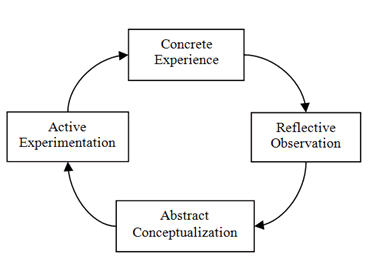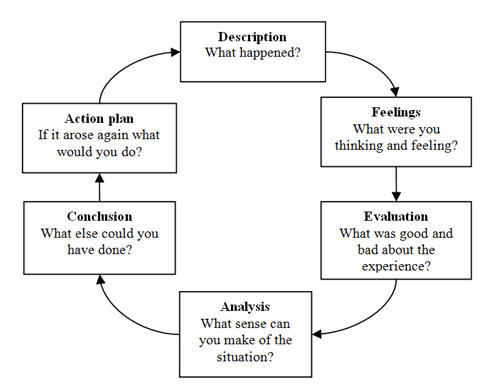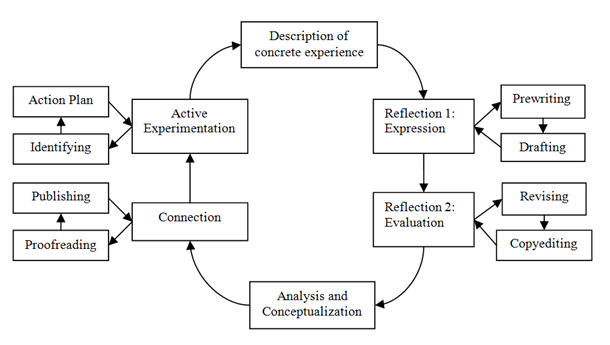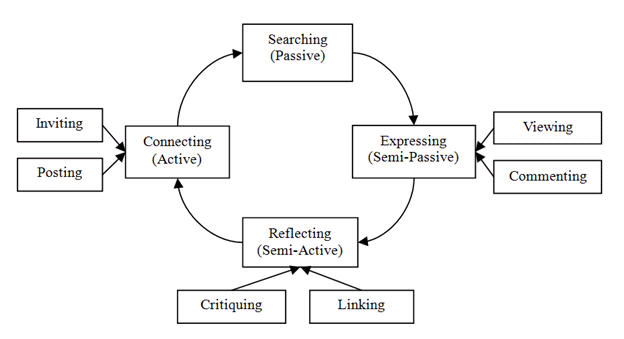Expression and Connection: The Integration of the Reflective Learning Process
and the Public Writing Process into Social Network Sites
|
Ji-Yong Park
Faculty of Education
Queensland University of Technology
Kelvin Grove, Queensland 4059 AU
jiyong.park@qut.edu.au
Jeong-Bae Son
Faculty of Education
University of Southern Queensland
Toowoomba, Queensland 4350 AU
jeong-bae.son@usq.edu.au
Abstract
A number of instructors have recently adopted social network sites (SNSs) for learning. However, the learning design of SNSs often remains at a preliminary level similar to a personal log book because it does not properly include reflective learning elements such as individual reflection and collaboration. This article looks at the reflective learning process and the public writing process as a way of improving the quality of reflective learning on SNSs. It proposes a reflective learning model on SNSs based on two key pedagogical concepts for social networking: individual expression and collaborative connection. It is expected that the model would be helpful for instructors in designing a reflective learning process on SNSs in an effective and flexible way.
Keywords: Online reflection; reflection process; reflective learning; public writing process; social network sites
|
Introduction
For the purpose of learning, social network sites (SNSs such as Facebook,MySpace, Elgg, and Ning) are being adopted by many instructors in many different contexts. An SNS is characterized by self-expression through public sharing and social interactions with a range of people (Ryberg & Larsen, 2008; Sharples, Graber, Harrison, & Logant, 2009). It allows users to express themselves with various media formats such as text, image, and video and to interact with others in different levels of relationship. Its flexible delivery and accessibility can attract learners as well as instructors to use SNSs for their particular learning or teaching purposes. However, Park and Kastanis (2009) identify three major obstacles in adopting SNSs for reflective learning: (1) insufficient time for reflective learning; (2) technical difficulties in using various media formats; and (3) insufficient integration of the reflective learning process and characteristics of SNSs. The focus of this article is on the third obstacle, which is an important pedagogical issue directly associated with learning design.
This article reviews the reflective learning process and the public writing process on SNSs and looks at the similarities and differences between the two processes from pedagogical perspectives. It discusses the possibility of creating a high quality level of social interactions and learning experiences. In doing so, it explores two key concepts for social networking, expression and connection, which allow developing a new model of the reflective learning process on SNSs. It is expected that the model helps instructors integrate a learning process with characteristics of SNSs and implement SNS-based reflective learning in an effective and flexible way.
Reflective Learning Process
Reflection can be viewed as a process of communication for deep learning and occurs in a variety of forms such as self-reflection and collaboration (Henderson, Napan, & Monteiro, 2004). As the role of reflection in the learning process is to allow learners to review their learning and practice, reflection leads learners to critical thinking for knowledge production and new solutions to problems. As noted by Branch and Paranjape (2002), reflection brings about “growth of the individual – morally, personally, psychologically, and emotionally, as well as cognitively” (p. 1187). However, reflection is often regarded as an annoying interruption and time consuming by learners (CALT Learning Support, 2007). Learners can become more introspective and anxious about their actions, and their lack of experience can affect the quality of their reflective practice (Ajeneye, 2005). This is the reason why “reflective practice requires continual evaluation of beliefs, assumptions and hypotheses against existing data” (Ajeneye, 2005, p. 573). In other words, there is a need to justify the measurement of the process, and reflective learning design should focus on the process of learners’ engagement with, and participation in, reflective practice. By reviewing two well-known reflective learning models (Kolb’s cycle of experiential learning and Gibbs’ reflective cycle), reflective learning process and its elements will be discussed below.
Kolb (1984) provides a descriptive model of the experiential learning process that shows how experience is translated through reflection into concepts (Figure 1). The learning process consists of four stages, which make for a circular process. The first stage, Concrete Experience, moves to the second stage, Reflective Observation, to the third stage, Abstract Conceptualization, and then to the fourth stage, Active Experimentation, leading learners back to the first stage. With Concrete Experience, the learner conceptualizes (Abstract Conceptualization) findings from reflection (Reflective Observation) and modifies or applies the concepts in other similar cases (Active Experimentation). The results of the experience lead learners to a new solution, approach, method, and knowledge which become another concrete experience. All these stages can happen over the short term or the long term and the circular process can happen at each stage. However, Kolb’s model does not articulate how a learner will engage at each stage so as to communicate with other learners and interact with technology. Thus, instructors need to customize learners’ needs by specifying learning objectives and activities of each stage based on their prior learning experiences and styles, and learning environments. This may cause ineffective usage of the process and result in poor support for the customization process.

Figure 1. Kolb’s (1984) cycle of experiential learning
On the other hand, Gibbs’ (1998) reflective cycle (Figure 2) consists of six stages: (1) Description of the situation; (2) Analysis of feelings; (3) Evaluation of the experience; (4) Analysis to make sense of the experience; (5) Conclusion with other considerations; and (6) Action plan for a similar situation. It is more descriptive than Kolb’s model to the extent that each stage has been extended to include a learner’s relevant reaction to each stage. In particular, Reflective Observation and Abstract Conceptualization of Kolb’s model have been extended in Gibbs’ model so that the former is split into Feelings and Evaluation and the latter into Analysis and Conclusion. In comparison with the process of Kolb’s model, the benefit of the Gibbs’ model is that the stages can be readjusted according to the purpose of reflection. For reflective writing, for instance, the stages 1 to 3 or to 4 can be formed as a complete circular process while the stage 4 (Analysis) can be applied to each stage (Centre for Learning and Teaching, 2005).

Figure 2. Gibbs’ (1998) reflective cycle
Reflective learning improves learners’ critical thinking and understanding of what they have learned (Park & Kastanis, 2009). Learners get benefits from reflective learning in terms of deep understanding of their strengths and weaknesses and identification of underlying values, possible insufficiencies, and areas for improvement (Henderson, Napan & Monteiro, 2004 ). In other words, reflective learning aims to reinforce deep learning and practice, not to focus on reflection itself. Thus, it is imperative to identify and customize each stage of the reflective learning process according to learning objectives and circumstances. It is also important for instructors and learners to adjust the reflective learning process to cater to their needs. Each stage of the process, in particular, needs to be articulated in terms of learners’ engagement and the process customized to fit into it.
When reflective writing is designed for collaboration on a n SNS, for example, it is necessary to integrate the reflective learning process and the writing process into the SNS, taking into account the learner’s background and circumstance. Reflection is more than self-critical thinking that can be a form of mutual communication with others. Herrington and Oliver (2002) point out that “socially-mediated reflection is enhanced considerably by collaboration” (p. 315) and collaboration on task maximizes reflective practice and enhances its process (Herrington & Oliver, 2002). Although the above two models dovetail with different stages of the learning process, therefore, manipulation seems necessary to customize learners’ engagement and participation types at each stage. When the models are applied into SNSs, further manipulation and customization of the entire process could be inevitable to realize socially-mediated reflection and collaboration.
Social Network Sites and the Writing Process
An SNS is cyberspace where people share information and stories and network each other, and where various human-to-human interactions take place (Boyd, 2007). As social networking is getting popular, millions of people create their own personal and professional networks through a number of SNSs ( Boyd & Ellison, 2007). Park and Kastanis (2009), for example, reveal that, out of 56 undergraduate students, all 56 students have their own blogs, 38 students hold more than two sites, and 34 students spend more than two hours on their sites daily. Ellison, Steinfield, and Lampe (2007) also report that 94 percent of their undergraduate students (n=286) are Facebook users and there is a strong association between the use of Facebook and social capital.
Key features of social networking on the Web are voluntary participation and user-generated content to create a socially networked community. Boyd and Ellison (2007) define SNSs as “web-based services that allow individuals to (1) construct a public or semi-public profile within a bounded system, (2) articulate a list of other users with whom they share a connection, and (3) view and traverse their list of connections and those made by others within the system” (p. 1).
SNSs can be used by individuals who lack technical and aesthetic skills. They provide online areas consisting of private and public zones that are “networked publics” and “public displays of connection” (Boyd, 2007). The nature of SNSs is sharing and connecting through interpersonal interactions that support sociability (Ryberg & Larsen, 2008). Thus, creating an SNS is equivalent to signing into the social network with others and consenting to be a participant in the online community (Boyd, 2007).
As previously mentioned, content writing on SNSs is open to the public, so the author of the content writes his/her message in consideration of the target readers with an expectation of a successful relationship. Strauss (2008) argues, “The writing process balances structure and expression so that what we offer is clear, concise, and compelling to the people we’re trying to reach” (The writing process as a model for social networking, section 1). To make a good social network with others, therefore, two things should be considered: the quality of content and quality contribution to others’ content (e.g., recommended links, visitors’ comments). Strauss (2008) considers public writing as the fundamental nature of SNSs and suggests the following writing process (Figure 3).

Figure 3. The public writing process on social network sites (Strauss, 2008)
In Strauss’ (2008) writing process, three steps on the left side focus on expression and the other three steps on the right side focus on structure. The three steps of expression are for writers themselves and the three steps of structure are for connections. The public writing process is useful in assisting writers in planning their writing and in helping them overview the writing process. Connecting activities through the steps of structure triggers tentative collaboration activities that are valuable for further social networking. However, Strauss’ writing process does not uncover reflection, although reflection can be enhanced through an individual’s expression in collaborative learning (Balafoutas, Sakonidis, & Hadjileontiadou, 2003). Also, interaction for collaboration on the Web has been over-generalized because it relies too much on an individual’s capacity to connect with others (Ryberg & Larsen, 2008). Therefore, it can be said that Strauss’ writing process focuses on the individual writer’s perspective rather than seeing values of reflective learning in line with communication and interaction that require writers to have a mind of active participation and collaboration (Ryberg & Larsen, 2008). This implies that the quality of reflective learning on SNSs requires the development of systematic process of expression and connection on the basis of the concept of collaborative learning, which can embrace participatory reflection and collaboration towards social networking.
Integrated Reflective Larning Process on Social Network Sites
SNSs can be used in teaching and learning environments, particularly for reflective learning, with the view that the characteristics of SNSs support the reflective learning process of individuals and collaboration (Furberg, 2009; Griffith & Liyanage, 2008; Herrington & Oliver, 2002 ). As pointed out by Hai-Jew (2008), the participatory and reflective learning via SNSs enhances learners’ engagement and helps learners balance between work and study . To integrate the reflective learning process and the writing process into SNSs for social networking, it seems clear that reflective learning has to be embedded into collaborative learning and connection activities on SNSs.
Expression process on social network sites
Figure 4 presents a framework of the expression process on SNSs, which combines Kolb’s and Gibbs’ reflection process and Strauss’ public writing process to define each stage of the writing process in terms of participatory reflective learning for social networking.

Figure 4. Expression process on social network sites
At the beginning stage, as shown in Figure 4, learners are asked to describe a concrete experience or to define a given problem and then move to the reflection stage. The reflection itself splits into two stages: Expression and Evaluation. Expression (Reflection 1) focuses on personal interests and expression of the topic; while Evaluation (Reflection 2) focuses on the target audience who perceives this reflection. Because reflection on SNSs is more than self-expression and self-reflection, public writing for social networking and connecting with others should be considered in the reflection-evaluation stage where the learner determines styles of writing and presentation to attract the target audience. In other words, it is important for learners to write their expression with the understanding of how their expression will be perceived by the target audience and how it will generate personal and professional networks (Ryberg & Larsen, 2008; Sharples et al., 2009). In this model, the purpose of writing on SNSs is to develop interaction and connection with the target audience.
At the Analysis and Conceptualization stage, learners conceptualize findings from their reflections and may modify them to present to the audience. After that, they seek practical ways of connecting with others. At the Connection stage, they respond to connection with others more actively than at the Expression stage by inviting and commenting on others’ content. Through connecting and communicating with others, they may move to the Active Experimentation stage that allows them to test reflection outcomes in new situations. In doing so, their reflection aims to create a new social network and types of their participation and involvement in SNSs need to assure quality reflection.
Connection process on social network sites
Figure 5 shows that the connection process consists of four stages: (1) Searching; (2) Expressing; (3) Reflecting; and (4) Connecting. These four stages illustrate how learners precede their reflections for social networking according to their participation levels. There are various activities available on SNSs that can be classified according to participation levels. In the circle of different levels (from passive to active), instructors determine what levels learners are expected to participate in and how they can facilitate and encourage learners’ expression and connection while learners plan what levels they intend to participate in, with what actions for each reflection stage.

Figure 5. Connection process on social network sites
Learners’ connection activities take place from the beginning stage and can be gradually incremented along with each stage of the connection process. Through the process, reflective learning allows learners to develop creative thinking and expression skills from diverse perspectives characterized by the medium itself. If reflective learning is designed to use more than text-based communication, for instance, it would require media manipulation skills such as digital image creation and audio/video production.
Reflective learning also encourages instructors and learners to research and develop effective communication and interaction methods. In the case of digital storytelling, Barrett (2006) argues that digital storytelling “ facilitates the convergence of the following four student-centered learning strategies: student engagement, reflection for deep learning, project-based learning, and the effective integration of technology into instruction” (p. 1). The pedagogical value of the use of communication technologies is that learners have the cultivation of the capacity to assess and adapt an appropriate medium for social networking. Therefore, media manipulation and production skills are authentically more than simple basic skills and each medium has its own pedagogical values in a certain learning environment.
The connection process is an iterative cycle of each stage of the expression process rather than a completely independent and separate process. It articulates the reflective learning process on SNSs and makes links with learners’ individual reflection and collaborative connection for social networking. As a result, it re-conceptualizes and re-materializes the expression process in SNSs environments collaboratively and socially.
An Exemplary Model: Web-based Reflective Learning
Table 1 below presents a customizable framework of web-based reflective learning (WBRL). To ensure all studnets experience the full potential of reflective leanring, every stage of the reflective learning process can be customized to cater for students’ experssion and connection in a learning management system ( LMS ) environment. The framework enables students to view the overall process of WBRL by linking expression and connection to the quality of their reflective learning.
Table 1 . A WBRL model
Stages |
Instructions
|
Initiation: idea development |
- Understand the task .
- Understand the target audience .
|
Preparation: idea development |
- Write ideas and concepts for the assignment with no more than 200 words by consideration of presenting it at a virtual group to get feedback from as many students as possible .
|
Expression: idea presentation in conjunction with the concept of connection |
- Express the idea and manipulate its presentation form to attract other members .
- Prepare supporting materials or resources for further explanation and clarification of their idea when questions are given from others .
- Think about how to attract others and encourage them leaving feedback to the idea if not received enough number of feedback .
|
Connection: give and take feedback in conjunction with the concept of expression |
- Give productive feedback to others’ ideas .
- Invite others to come to see your own idea .
- Present the idea in effective and creative ways .
- Respond to others’ feedback on your own idea for deep discussion which happens through social interactions .
- Take a collaborative approach to receive productive feedback which help s the final project .
|
Reification : collection of peers’ feedback |
- Select five students’ feedback only for your reflection .
- Collect your own feedback given to the others for your reflection .
- While critically reviewing your critical understanding of the feedback you gave and were given, reify your ideas for the final project .
|
Reflection: reflective writing |
- Based on your critical understanding of collaborative and individual feedback, write your reflection in terms of how the feedback has influenced your project development.
- The collected feedback must be attached with either/both indirect or/and direct quotations.
|
Actualisation |
- Apply the reflection outcomes to the project .
- Complete the assignment .
|
Evaluation |
- Receive results of the assessment .
- Undertake self reflection on the entire assignment.
|
|
The framework was originally developed to guide the design of a WBRL assignment for first year students in an education course. At the begining of the assignment, students were randomly allocated to a virtual group through a LMS. Each group comprised of twenty students. As part of the assignment , the students were asked to collect feedback about their assignment ideas from at least five peers. As a result, they could build connections with other peers in terms of collaborative participation in their virtual group over five weeks.
Conclusion
This article has looked at the differences between the reflective learning process and the writing process on SNSs and discussed how the reflective learning process can be effectively merged into SNSs from a viewpoint of the public writing process. It has proposed the expression process and the connection process on SNSs and explained that the connection process assists each stage of the expression process in an iterative design cycle.
As discussed so far, expression and connection are the most important elements for both social networking and pedagogical practice in reflective learning on SNSs. Implications of this article include: (1) SNSs provide public writing experiences through expression and connection - the reflection process needs to be integrated with these two processes; (2) the ways and levels of participation can vary depending on learner needs and learning objectives – the participation needs to be linked to the expression and connection processes to facilitate collaboration and social networking; and (3) media types for content development and distribution need to be strategically applied to the expression and connection activities as they affect the quality of social networking.
References
Ajeneye, F. (2005). Reflective practice: A biomedical scientist’s perspective. The Biomedical Scientist, 49, 573-574.
Balafoutas, G. J., Sakonidis, H. N., & Hadjileontiadou, S. J. (2003). Lin2k: A novel Web-based collaborative tool-application to engineering education. Journal of Engineering Education, 4, 313-324.
Barrett, H. (2006). Researching and Evaluating Digital Storytelling as a Deep Learning Tool. In C. Crawford et al. (Eds.), Proceedings of Society for Information Technology & Teacher Education International Conference 2006 (pp. 647-654). Chesapeake, VA: AACE. Retrieved December 18, 2009, from http://electronicportfolios.org/portfolios/SITEStorytelling2006.pdf
Boyd, D. (2007). Social network sites: Public, private, or what? The Knowledge Tree, 13. Retrieved September 25, 2009, from http://kt.flexiblelearning.net.au/tkt2007/?page_id=28
Boyd, D. M., & Ellison, N. B. (2007). Social network sites: Definition, history, and scholarship. Journal of Computer-Mediated Communication, 13 (1), 210–230. Retrieved December 5, 2009, from http://onlinelibrary.wiley.com/doi/10.1111/j.1083-6101.2007.00393.x/pdf
Branch, W. T., & Paranjape, A. (2002). Feedback and reflection: Teaching methods for clinical settings. Academic Medicine , 77(12), 1185-1188.
CALT Learning Support. (2007). Reflective writing. Monash University. Retrieved December 1, 2009, from http://www.monash.edu.au/lls/llonline/writing/medicine/reflective/index.xml
Centre for Learning and Teaching. (2005). Learning unit: Reflective practice. University of Brighton. Retrieved December 5, 2009, from http://staffcentral.brighton.ac.uk/clt/events/documents/Ramage%20Example%203.doc
Ellison, N.B., Steinfield, C., & Lampe, C. (2007). The benefits of Facebook ‘friends’: social capital and college students’ use of online social network sites. Journal of Computer-mediated Communication, 12(4), 1143–1168
Furberg, A. (2009). Socio-cultural aspects of prompting student reflection inWeb-based inquiry learning environments. Journal of Computer Assisted Learning, 25 (4), 397-409.
Gibbs, G. (1998) .Learning by doing: A guide to teaching and learning. London: FEU.
Griffith, S., & Liyanage, L. (2008). An introduction to the potential of social networking sites in education. In I. Olney, G. Lefoe, J. Mantei, & J. Herrington (Eds.), Proceedings of the Second Emerging Technologies Conference 2008 (pp. 76-81). Wollongong: University of Wollongong. Retrieved November 2, 2009, from http://ro.uow.edu.au/etc08/9
Hai-Jew, S. (2008). Culturally targeted online course redesigns for English composition and research writing: A case study. Journal of Online Learning and Teaching, 4, 1, 94-108. Retrieved November 10, 2009, from https://jolt.merlot.org/vol4no1/hai-jew0308.pdf
Henderson, K., Napan K. & Monteiro, S. (2004). Encouraging reflective learning: An online challenge. In R. Atkinson, C. McBeath, D. Jonas-Dwyer & R. Phillips (Eds), Beyond the comfort zone:Proceedings of the 21st ASCILITE Conference (pp. 357-364). Perth, 5-8 December. Retrieved November 30, 2009, from http://www.ascilite.org.au/conferences/perth04/procs/henderson.html
Herrington, J., & Oliver, R. (2002). Designing for reflection in online courses. In Quality Conversations, Proceedings of the 25th HERDSA Annual Conference (pp. 313-329). Perth, Western Australia, 7-10 July. Retrieved November 29, 2009, from http://www.herdsa.org.au/wp-content/uploads/conference/2002/papers/HerringtonJ.pdf
Kolb, D. (1984). Experiential learning: Experience as the source of learning and development. Englewood Cliffs, NJ: Prentice-Hall.
Park, J.Y., & Kastanis, L.S. (2009). Reflective learning through social network sites in design education. International Journal of Learning,16(8), 11-22.
Ryberg, T., & Larsen, M.C. (2008). Networked identities: understanding relationships between strong and weak ties in networked environments. Journal of Computer Assisted Learning, 24(2), 103-115.
Sharples, M., Graber, R., Harrison, C., & Logant, K. (2009). E-safety and Web 2.0 for children aged 11–16. Journal of Computer Assisted Learning, 25 (1), 70-84.
Strauss, L. (2008, April 14). Pre-networking - How well do you know your social networking sites? Retrieved December 1, 2009, from http://www.successful-blog.com/1/pre-networking-how-well-do-you-know-your-social-networking-sites





